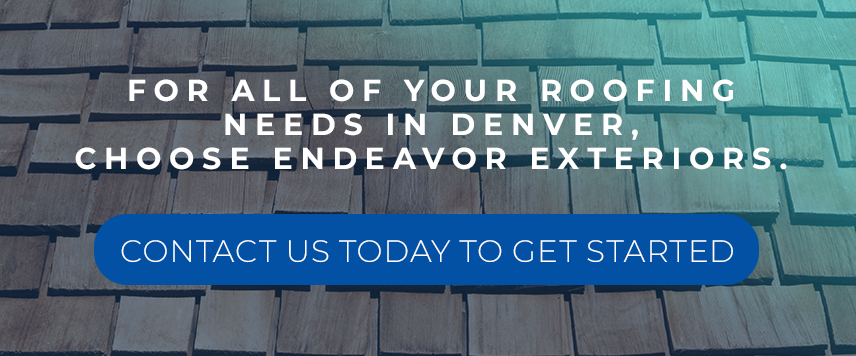Knowing what causes roof leaks could help you catch them early on.
Roof leaks may seem like no big deal, but if you leave a roof leak unattended for too long, it can cause serious damage to your home. However, if a roof leak is caught and repaired right away, it’s much cheaper to fix and won’t cause nearly as much damage. But, in order to actually catch a roof leak, you have to know what causes them in the first place, and how to spot the signs. That’s why the roofing experts at Endeavor Exteriors in Denver have come up with this list of the top 10 most common causes of leaky roofs:#1. Broken or Missing Shingles
There are many things that can endanger the integrity of your shingles. Excessive sunshine exposure, for instance, causes shingles to dry out, crack and break off. Heavy wind can cause shingles to curl up or blow off. Hail can put dents and cracks in your shingles. Even age can deteriorate your shingles. If your shingles are damaged or missing for any reason, it leaves your roof susceptible to leaks.How do you identify broken or missing shingles?
Since shingles make up the outermost layer of your roof, most shingle damage will be obvious. Look for any discolored patches on your roof — this indicates missing shingles. You should also check the gutters and the ground for any shingle granules that have fallen off.#2. Cracked Flashing
Roof flashing is thin, metal pieces that are installed in areas of the roof that are prone to leaking, like around the chimney, skylights and plumbing fixtures. Flashing is intended to prevent water from penetrating these areas, but they don’t last forever. The tar used to seal the flashing together can start to corrode with time, or the caulking may crack. Additionally, exposure to rain, wind and other elements can lead to cracks. Sometimes, flashing leaks occur due to improper installation, which can cause the flashing to fall out of place.How do you identify cracked flashings?
Keep a close eye on your roof flashing, watching for any signs of rust, corrosion, cracks, dents or bends in the flashing; you should also watch out for missing flashing. Other signs that you may have flashing damage on your hands are staining or mold on the fascia boards or water-damaged shingles.#3. Improperly Sealed Roof Valleys
The valleys of your roof are the areas where two different planes come together. And because most roofs are sloped, the valleys are prone to roof leaks and need to be properly sealed in order to keep moisture out. If the roof valleys were properly sealed when the roof was installed, it makes the roof prone to leaks. The seal in roof valleys can also get cracked if it’s stepped on, or it can erode over time after being exposed to ice and rain.How do you identify damage to roof valley seals?
Spotting damaged or improperly sealed roof valleys is fairly straightforward, and you’ll want to look for wet spots running along your roof’s seams. If you’re unsure if your roof valleys are properly sealed, it’s also a great idea to get your roof inspected by a professional.#4. Ice Dams
Ice dams occur in the winter on homes that don’t have proper ventilation or insulation in the attic. Without proper ventilation, the heat building up in the attic has nowhere to go, and it causes snow and ice to melt at the top of the roof. The water then runs down to the edges of your roof, and since the heat from the attic is no longer there, it refreezes, forming a ridge of ice. That ice ridge prevents any other moisture on your roof from escaping, leaving it to seep into your roof and cause leaks. Plus, the weight of the ice ridge puts excess weight on your roof edge, which can also cause damage.How do you identify an ice dam?
Those lovely icicles that adorn our homes in the winter are actually a common sign that you have an ice dam on your roof. You can also spot the signs of an ice dam by looking for water stains on the inside of your home, in the attic, as well as on the tops of your home’s exterior walls.#5. Age
How old is your roof? If you have an asphalt shingle roof, and it’s more than 20 years old, it could be at risk for leaks. Over time, your roofing materials will start to deteriorate and break down, making it prone to leaks, and this is especially true if you haven’t stayed on top of maintaining your roof as you should.How do you identify an aging roof?
Like we mentioned, if your asphalt shingle roof is more than 20 years old, it’s not a bad idea to have a professional come out and evaluate your roof. But, if you’re not sure how old your roof is, there are some signs you can watch out for that indicate an aging roof, including curling shingles, dark spots, cracked sealant, damaged underlayment and blistering paint.For professional leak repair in Denver, turn to Endeavor Exteriors.
If you have a leaky roof, don’t wait until the damage gets more severe or expensive to fix it. Take a proactive approach by taking advantage of the professional roofing services from Endeavor Exteriors today.Want to learn about the last five most common causes of roof leaks? If so, make sure that you stay tuned for our next blog!
Tags
Subscribe to Endeavor Exteriors's Blog



Comments